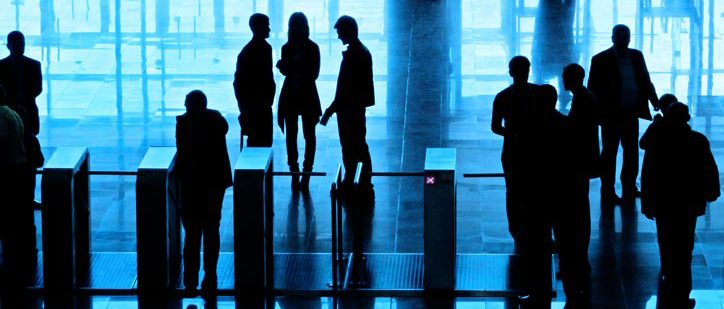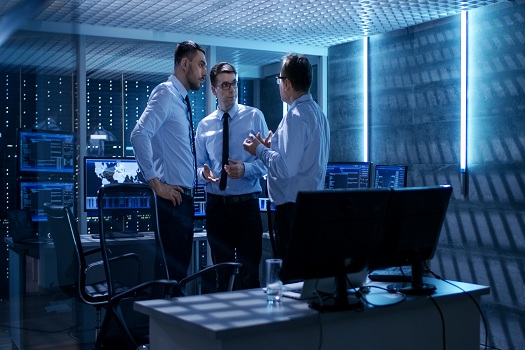Safeguarding Your Company: Corporate Security Basics Revealed
Wiki Article
From Cybersecurity to Physical Actions: Reinforcing Company Protection in a Transforming Globe
By combining the strengths of both cybersecurity and physical safety and security, firms can create a detailed protection technique that addresses the diverse variety of hazards they deal with. In this conversation, we will certainly discover the transforming danger landscape, the need to integrate cybersecurity and physical safety and security, the implementation of multi-factor authentication steps, the significance of worker understanding and training, and the adjustment of safety measures for remote workforces. By analyzing these key areas, we will gain important insights right into how organizations can reinforce their corporate protection in an ever-changing world.Understanding the Altering Hazard Landscape
The developing nature of the contemporary world demands an extensive understanding of the altering risk landscape for efficient corporate security. It is essential for organizations to remain informed and adapt their security determines to resolve these evolving risks.One key facet of recognizing the changing risk landscape is identifying the different sorts of dangers that organizations face. Cybercriminals are regularly developing brand-new techniques to make use of vulnerabilities in computer system systems and networks. These dangers can vary from malware and ransomware assaults to phishing scams and social design techniques. Additionally, physical risks such as theft, criminal damage, and company reconnaissance continue to be prevalent issues for organizations.
Surveillance and assessing the risk landscape is essential in order to identify potential risks and susceptabilities. This includes staying upgraded on the most recent cybersecurity trends, evaluating threat knowledge records, and conducting routine risk evaluations. By recognizing the changing danger landscape, organizations can proactively implement ideal safety steps to reduce dangers and shield their properties, reputation, and stakeholders.
Integrating Cybersecurity and Physical Safety And Security
Integrating cybersecurity and physical security is vital for comprehensive corporate protection in today's digital and interconnected landscape. As organizations progressively count on innovation and interconnected systems, the borders between physical and cyber threats are becoming blurred. To properly safeguard against these threats, an alternative method that incorporates both cybersecurity and physical safety actions is crucial.Cybersecurity concentrates on protecting electronic assets, such as systems, networks, and information, from unapproved gain access to, disturbance, and theft. Physical safety and security, on the other hand, encompasses steps to protect physical assets, people, and centers from susceptabilities and hazards. By integrating these 2 domain names, organizations can address susceptabilities and threats from both electronic and physical angles, therefore improving their total safety position.
The combination of these 2 techniques allows for an extra detailed understanding of safety threats and enables a unified response to occurrences. As an example, physical gain access to controls can be boosted by integrating them with cybersecurity methods, such as two-factor authentication or biometric recognition. Cybersecurity measures can be matched by physical safety and security steps, such as surveillance video cameras, alarms, and protected access points.

Executing Multi-Factor Verification Steps
As companies progressively focus on extensive protection procedures, one reliable method is the implementation of multi-factor verification measures. Multi-factor verification (MFA) is a security technique that calls for individuals to provide several kinds of recognition to access a system or application. This method adds an added layer of protection by combining something the customer knows, such as a password, with something they have, like a protection or a fingerprint token.By carrying out MFA, organizations can substantially enhance their protection position - corporate security. Standard password-based verification has its restrictions, as passwords can be conveniently compromised or failed to remember. MFA mitigates these dangers by including an additional authentication element, making it extra tough for unapproved people to gain accessibility to delicate details
There are several kinds of multi-factor verification methods available, including biometric authentication, SMS-based confirmation codes, and equipment symbols. Organizations require to analyze their details needs and select one of the most ideal MFA solution for their needs.
However, the execution of MFA need to be meticulously planned and executed. It is crucial to strike a balance in between security and use to avoid customer frustration and resistance. Organizations needs to also think about potential compatibility issues and provide adequate training and assistance to ensure a smooth shift.
Enhancing Employee Understanding and Training
To enhance company protection, organizations need to focus on boosting staff member understanding and training. Several security breaches happen due to human error or lack of understanding.Reliable staff member awareness and training programs should cover a large range of topics, including information security, phishing attacks, social design, password health, and physical safety and security procedures. These programs need to be customized to the certain requirements and duties of various staff member duties within the company. Normal training workshops, simulations, and sessions can aid staff members establish the essential my site skills and understanding to identify and react to safety hazards efficiently.
In addition, companies must motivate a culture of security recognition and provide ongoing updates and suggestions to maintain employees educated regarding the most up to date risks and reduction methods. This can be done through inner interaction channels, such as e-newsletters, intranet portals, and e-mail projects. By promoting a security-conscious workforce, organizations can considerably decrease the possibility of safety incidents and shield their important possessions from unauthorized accessibility or concession.

Adapting Security Actions for Remote Labor Force
Adapting business protection measures to accommodate a remote labor force is necessary in guaranteeing the security of delicate details and assets (corporate security). With the enhancing pattern of remote job, companies need to apply appropriate safety and security procedures to reduce the dangers related to this brand-new means of functioningOne critical aspect of adapting safety and security steps for remote work is establishing safe interaction networks. Encrypted messaging platforms and online exclusive networks (VPNs) can help protect sensitive information and prevent unauthorized accessibility. In addition, companies must implement using strong passwords and multi-factor verification to boost the protection of remote gain access to.
An additional vital consideration is the implementation of top article secure remote accessibility services. This includes providing staff members with secure access to business resources and data through digital desktop facilities (VDI), remote desktop procedures (RDP), or cloud-based options. These innovations make certain that delicate info continues to be safeguarded while allowing staff members to do their roles properly.

Lastly, detailed safety and security awareness training is vital for remote employees. Educating sessions must cover best methods for safely accessing and dealing with delicate details, determining and reporting phishing efforts, and maintaining the overall cybersecurity health.
Final Thought
In verdict, as the threat landscape remains to advance, it is crucial for companies to enhance their safety and security measures both in the cyber and physical domain names. Incorporating cybersecurity and physical security, carrying out multi-factor verification measures, and boosting worker understanding and training are essential steps towards accomplishing robust corporate security. In addition, adapting protection measures to accommodate remote labor forces is vital in today's transforming world. By carrying out these measures, companies can reduce dangers and safeguard their important possessions from possible threats.In this conversation, we will discover the transforming threat landscape, the demand to incorporate cybersecurity and physical safety and security, the application of multi-factor verification find out steps, the importance of employee understanding and training, and the adaptation of security procedures for remote labor forces. Cybersecurity procedures can be enhanced by physical safety and security measures, such as surveillance electronic cameras, alarm systems, and protected accessibility points.
As companies increasingly prioritize extensive protection measures, one effective strategy is the implementation of multi-factor verification actions.In verdict, as the hazard landscape continues to progress, it is vital for organizations to reinforce their safety and security determines both in the cyber and physical domain names. Integrating cybersecurity and physical safety, executing multi-factor authentication measures, and enhancing worker recognition and training are crucial steps in the direction of attaining robust company safety and security.
Report this wiki page